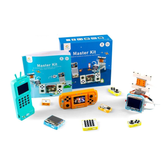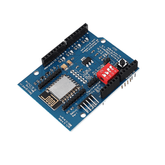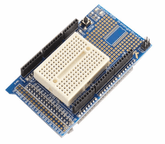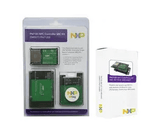-
Arduino 16X2 LCD Keypad Shield16X2 LCD Keypad Shield for Arduino The LCD keypad shield is suited for Arduino UNO board and Leonardo Board compatible with Arduino. The blue LCD Keypad Shield is sometimes called a navigation shield because it comes with 6 momentary push buttons for menu navigation. Besides the push button,...
- Rs. 189
Rs. 297- Rs. 189
- Unit price
- per
Save Rs. 108 -
Arduino UNO USB Host ShieldUNO USB Host Shield for Arduino The UNO USB Host Shield compatible with Arduino is based on the MAX3421E, which is a USB peripheral/host controller containing the digital logic and analog circuitry necessary to implement a full-speed USB peripheral or a full-/low-speed host compliant to...
- Rs. 580
Rs. 999- Rs. 580
- Unit price
- per
Save Rs. 419 -
Arduino UNO R3, Leonardo Multifunctional Expansion BoardMultifunctional Expansion Board The multifunctional expansion board is a perfect expansion board for enthusiast who are getting started with Arduino. The expansion board is best compatible with UNO board and Leonardo boards compatible with arduino. It has range of features which makes it ideal for...
- Rs. 133
Rs. 199- Rs. 133
- Unit price
- per
Save Rs. 66 -
Arduino Ethernet ShieldEthernet W5100 Shield for Arduino The Arduino Ethernet Shield enables an Arduino board to connect to the internet using the Wiznet W5100 ethernet chip. This chip provides a network (IP) stack that supports both TCP and UDP protocols. The Ethernet W5100 Shield Network Expansion...
- Rs. 596
Rs. 999- Rs. 596
- Unit price
- per
Save Rs. 403 -
Arduino Data Logger ShieldData Logger Shield for Arduino This data logger is best suited for UNO boards, Leonardo Boards or Mega boards compatible with Arduino. It helps these development boards to log sensor data to an SD card with the minimum of set-up. The shield contains appropriate level shifting...
- Rs. 141
Rs. 221- Rs. 141
- Unit price
- per
Save Rs. 80 -
Arduino UNO ESP8266 Serial wifi Expansion Board ModuleESP8266 Serial wifi Expansion Board Module for Arduino UNO The ESP8266 Serial WiFi Expansion Board Module is nothing but the ESP8266 ESP-12E UART Wireless WIFI Shield TTL Converter (Shield WiFi ESP8266) makes it easy to connect the Arduino to WiFi networks through the ESP8266....
- Rs. 309
Rs. 399- Rs. 309
- Unit price
- per
Save Rs. 90 -
Arduino Data Logger Shield for Boards CompatibleData Logger Shield The Data Logging Shield of "Deek-Robot" is supplied with an RTC (DS1307) and thus has an extra compartment for a button cell. The SD Card Slot is designed for Micro SD Card. Onboard 3.3V regulator is both a reliable reference voltage and...
- Rs. 151
Rs. 184- Rs. 151
- Unit price
- per
Save Rs. 33 -
Arduino Nano 3D Printer CNC Shield V4 Expansion Board3D Printer CNC Shield V4 Expansion Board for Nano Board CNC shield V4 needs to work with the Nano board. It can be used as a driver’s expansion board for engraving machines and 3D printers. It has in total 3 channel slots for A4988 stepper motor...
- Rs. 163
Rs. 349- Rs. 163
- Unit price
- per
Save Rs. 186 -
Arduino VS1053 MP3 ShieldVS1053 MP3 Shield for Arduino This VS1053 MP3 Shield for Arduino with onboard recording function can record and playback a variety of music formats, and support for OGG encoding real-time recording. VS1053 is in addition to playing a variety of music formats but also...
- Rs. 829
Rs. 999- Rs. 829
- Unit price
- per
Save Rs. 170 -
Arduino Sensor Shield V4.0 Expansion BoardSensor Shield V4.0 Expansion Board The Sensor Shield V4.0 is a small circuit board designed to enhance the capabilities of certain Arduino microcontroller models such as the Uno, Leonardo, and Mega. With this expansion board, users can easily connect and utilize a variety of...
- Rs. 119
Rs. 184- Rs. 119
- Unit price
- per
Save Rs. 65 -
Arduino MEGA Prototype Shield V3MEGA Prototype Shield V3 The Arduino-compatible MEGA Prototype Shield V3.0 comes equipped with a breadboard, allowing you to easily construct circuits. The Arduino shield features a gold PCB sink process and a compact mainboard with small golden square pad spacing, making it convenient to...
- Rs. 124
Rs. 198- Rs. 124
- Unit price
- per
Save Rs. 74 -
Arduino xBee ShieldxBee Shield for Arduino xBee shield Modules are great for long range wireless communications and to implement complex mesh networks. But using them in your projects has always been difficult because of the xBee modules odd pin spacing, voltage regulator and level shifter requirements. This...
- Rs. 147
Rs. 199- Rs. 147
- Unit price
- per
Save Rs. 52 -
Arduino LCD TFT01 Shield for Mega Board compatibleLCD TFT01 Shield for Mega Board compatible with Arduino This is the TFT01 Shield for Mega Board compatible with Arduino, With this module you can directly plug the TFT01 in the shield and stand on the MEGA board. The TFT01 LCD supports 8-bit mode, can use...
- Rs. 219
Rs. 411- Rs. 219
- Unit price
- per
Save Rs. 192 -
PN7120 NFC Controller SBC KitPN7120 NFC Controller SBC Kit The OM5577/PN7120S is a flexible and easy-to-use PN7120 NFC controller Single Board Computer (SBC) kit with a Raspberry Pi interface board, as well as a BeagleBone interface board. It enables the development of an NFC solution based on PN7120...
- Rs. 4,499
Rs. 5,016- Rs. 4,499
- Unit price
- per
Save Rs. 517 -
Dual Monster Moto Shield VNH3ASP30 DC Motor DriveDual Monster Moto Shield The Motor Driver Shield Monster Moto has been upgraded to the Dual Monster Moto Shield VNH3ASP30 DC Motor Driver 2x14A (Peak 30A). This new version features a pair of VNH3ASP30 full-bridge motor drivers, replacing the previous L298 H-bridge. The support...
- Rs. 3,499
Rs. 4,499- Rs. 3,499
- Unit price
- per
Save Rs. 1,000 -
Cytron Robo Uno Shield for Arduino -The All-In-One Robotics ShieldCytron Robo Uno Shield for Arduino -The All-In-One Robotics Shield The Cytron Robo Uno Shield, also known as the Robo Uno Shield, is the ultimate all-in-one Arduino robotics shield for creators, educators, and STEM enthusiasts. Designed to make robot building effortless and fun, this...
- Rs. 1,349
Rs. 1,889- Rs. 1,349
- Unit price
- per
Save Rs. 540 -
DFRobot Fermion Serial Data Logger V2.0 for ArduinoDFRobot Fermion Serial Data Logger V2.0 for Arduino The Fermion Serial Data Logger V2.0 is an upgraded version of the original data logger that makes storing Arduino data simpler than ever before. Unlike previous MicroSD card modules, this compact device allows you to print...
- Rs. 649
Rs. 899- Rs. 649
- Unit price
- per
Save Rs. 250 -
DFRobot Gravity V2.0 Serial Data Logger for ArduinoDFRobot Gravity V2.0 Serial Data Logger for Arduino The DFRobot Gravity V2.0 Serial Data Logger for Arduino offers a simple and efficient solution for storing data in Arduino-based projects. Unlike traditional MicroSD card modules, this logger comes with 128MB of onboard flash memory, eliminating...
- Rs. 1,269
Rs. 1,535- Rs. 1,269
- Unit price
- per
Save Rs. 266 -
Official Arduino Portenta CAT.M1/NB IoT GNSS Shield - ASX00027Official Arduino Portenta CAT.M1/NB IoT GNSS Shield The Arduino Portenta CAT.M1/NB IoT GNSS Shield enhances your Arduino Portenta applications with robust cellular and precise positioning capabilities. Leveraging the Thales Cinterion TX62 wireless module, this Portenta LTE Shield delivers highly efficient, low-power Cat.M1 and NB-IoT...
- Rs. 6,899
Rs. 11,499- Rs. 6,899
- Unit price
- per
Save Rs. 4,600 -
Official Arduino Portenta Vision Shield with LORA Connectivity - ASX00026Official Arduino Portenta Vision Shield with LORA Connectivity The Official Arduino Portenta Vision Shield with LoRa Connectivity is an advanced hardware extension designed for the Arduino Portenta family, specifically the Portenta H7. This shield enables powerful edge AI applications by combining embedded computer vision...
- Rs. 7,149
Rs. 9,999- Rs. 7,149
- Unit price
- per
Save Rs. 2,850

Best Price Guarantee

Ready Stock for Bulk Purchase

Dedicated Account Managers

5% GST Benefits for Eligible SEZ and Edu

Technical Support Available

1-Year Manufacturer Warranty






















































